Phonic Ear 330T216 Easy Listener II Transmitter User Manual
Phonic Ear, Inc. Easy Listener II Transmitter Users Manual
Users Manual
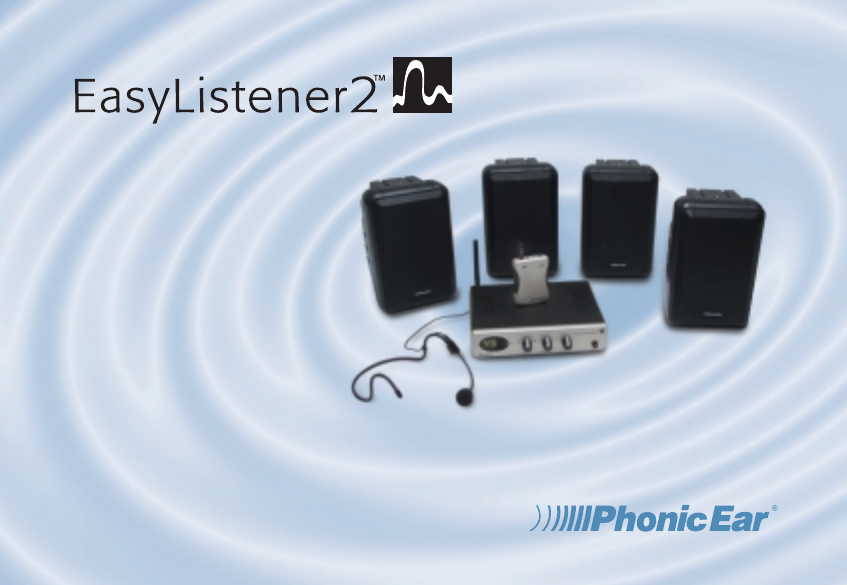
user guide
230R receiver
330T transmitter
470-2856-119 compact speaker
AT0806 distributed ceiling speaker
AT0664 cluster ceiling speaker
216MHz
3745 EL2 System User Guide 2/24/04 4:29 PM Page 2

contents
advanced system setup
advanced speaker daisy-chaining . . . . .49-51
adjusting 3 band equalizer . . . . . . . . . . . .52
adjusting squelch . . . . . . . . . . . . . . . . . . .53
optional accessories (not included) . . .54-55
troubleshooting . . . . . . . . . . . . . . . . . .56-57
caring for your system . . . . . . . . . . . . . . .58
Phonic Ear channel numbers and
corresponding frequencies . . . . . . . . . . . .59
product specifications . . . . . . . . . . . . .60-62
warranty . . . . . . . . . . . . . . . . . . . . . . .63-65
code of federal regulations . . . . . . . . .66-67
regulatory approvals . . . . . . . . . . . . . . . . .68
introduction . . . . . . . . . . . . . . . . . . . . . . . .1
understanding sound field and its benefits .2
installation tips . . . . . . . . . . . . . . . . . . . . .3
basic system guidelines . . . . . . . . . . . . . .4
basic system package components
and accessories . . . . . . . . . . . . . . . . . . .5-6
230R receiver features . . . . . . . . . . . . .7-8
330T transmitter features . . . . . . . . . .9-10
230R setup and operation . . . . . . . . . . . . . .11-13
330T setup and operation . . . . . . . . . . . . . .14-22
330T transmitter aux-in . . . . . . . . . . .23
230R receiver aux-in . . . . . . . . . . .24-25
auxiliary output . . . . . . . . . . . . . . .26-33
speaker setup . . . . . . . . . . . . . . . . .34-35
compact speakers . . . . . . . . . . . . . . . .36-41
distributed ceiling speakers . . . . . . . . .42-45
cluster ceiling speaker . . . . . . . . . . . .46-48
3745 EL2 System User Guide 2/24/04 4:29 PM Page 6

introduction
Congratulations on the purchase of your new EasyListener 2 sound field system! With proper
care and use it will become one of your most valuable classroom tools for many years.
Students will be able to consistently and easily understand what the teacher is saying,
regardless of his/her location in the classroom. Teachers can now speak all day in their
normal voice and will suffer far fewer vocal problems as a result.
Numerous studies show that classrooms using sound field enjoy better student comprehen-
sion, increased student participation, better grades and fewer behavioral referrals.
Read this manual carefully to become familiar with your system and to get the most out of
its many features and options.
1
3745 EL2 System User Guide 2/24/04 4:29 PM Page 7
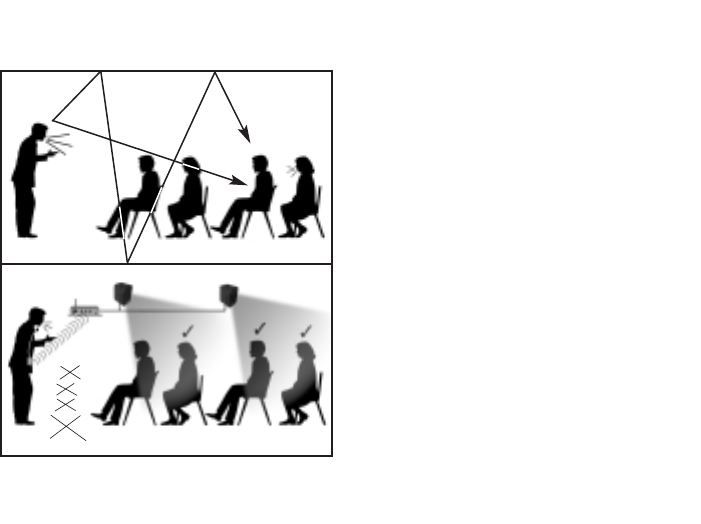
understanding sound field and its benefits
?
• distance
• noise
• echo
• vocal
fatigue
cough!
• distance
• noise
• echo
• vocal
fatigue
?
without sound field
with sound field
2
3745 EL2 System User Guide 2/24/04 4:29 PM Page 8

Before you set up your system, take a good look around your room. Where are the outlets
located? Where are the computers and other electronic equipment? Where can you put your
receiver so it's easy for you to reach, but out of the way of students and main traffic areas?
Though each classroom is different, there are some general guidelines for both receiver and
speaker placement:
The receiver — should be in the front of the classroom at teacher's eye level when standing,
close to a wall outlet. Try to keep it at least six feet (19.5 meters) away from computers or other
electronic equipment, since there may be interference if it is placed too close to these devices.
Compact wall speakers — should be mounted as high as possible and angled down
toward the listeners' ears. Place them around the room so there is even coverage in the listening
area (where the students are seated). Use as many as needed — four is recommended.*
Distributed ceiling speakers — space them evenly above the students’ seating area.
A minimum ceiling height of 10 feet is necessary, and 12 feet is even better. Use as many
as needed — a minimum of four is recommended.*
Cluster ceiling speaker — should be centered directly over the students’ seating area.
A minimum ceiling height of 12 feet is recommended, and 14 feet is even better.
* For optimal speaker placement, download Sound field Wizard software from our website at www.phonicear.com.
installation tips
3
3745 EL2 System User Guide 2/24/04 4:29 PM Page 9

basic system guidelines
To help ensure that you get the most out of your new sound field system, we have put
together the following list of suggested guidelines:
Charge the batteries every night. Rechargeable Nickel Metal Hydride batteries (included
with system) last approximately 12 hours between charges, but should be recharged every
night so they are ready to go in the morning. Plan on buying new NiMH batteries (only
Phonic Ear brand can be used) after 12 months of use. Alkaline batteries can also be used
as backups, and will last approximately 15 hours. Alkaline batteries cannot be recharged
by the system.
Do not coil the microphone cord. Since it also acts as your antenna, coiling or wrap-
ping the cord will affect its range and may also reduce its life.
Speak at a normal level — the system is projecting your voice for you.
Periodically check the volume and OptiVoice settings. These are often set and
then forgotten, but if accidentally changed, will affect how your system sounds.
4
3745 EL2 System User Guide 2/24/04 4:29 PM Page 10
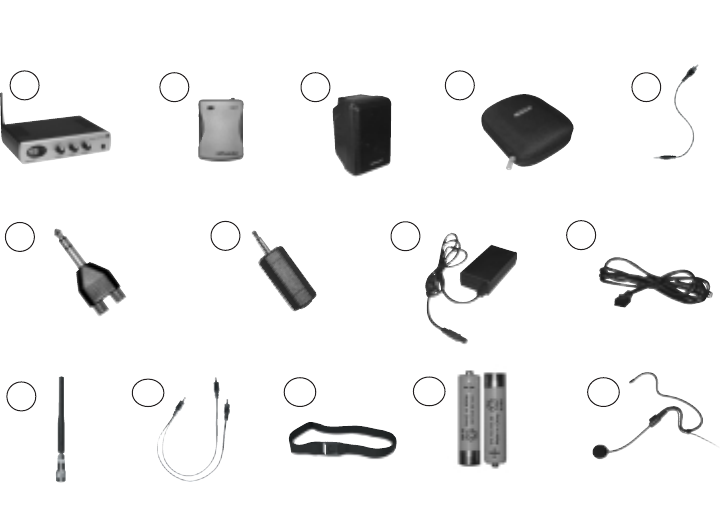
5
basic system package components and accessories
5
678
10
4
11 12 13 14
9
12 3
3745 EL2 System User Guide 2/24/04 4:29 PM Page 11

6
5 aux out cable/(RCA 3.5mm)
(AT0805)
6 aux-in adaptor plug /(1
/4in– Dual RCA)
(310-2544-1342)
7 aux-out adaptor plug/(3.5mm – 2.5mm)
(310-2544-1341)
8 power supply, receiver
(040-7402-105)
10 antenna, receiver
(AT0831)
4 accessory/transmitter kit
(841-6440-101)
11 330T transmitter charging cord
(1.3mm – Dual 1.3mm)
(300-6497-105)
12 elastic belt
(AT0712)
13 rechargeable AAA batteries
(374-30-310-09)
14 microphone/(AT0655 boom
microphone shown here)
9 power cord, receiver (USA/CAN)
(AT0787)
2 330T body-worn transmitter
1 230R base station receiver
3 speakers
(compact wall speaker shown here)
*speakers packaged separately
3745 EL2 System User Guide 2/24/04 4:29 PM Page 12
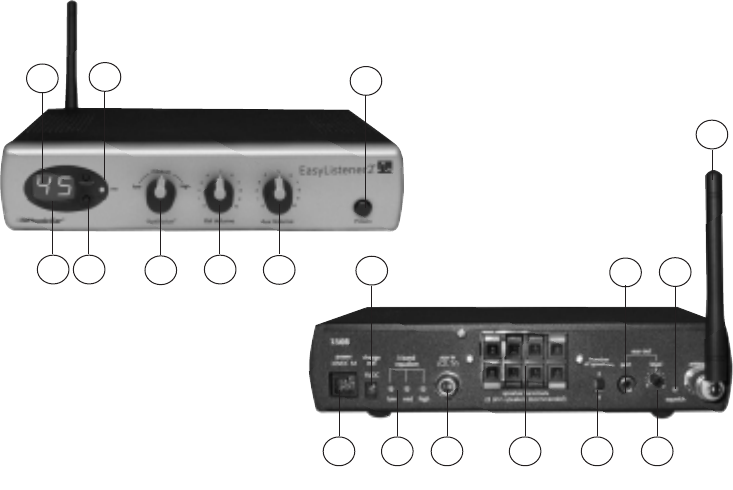
7
230R receiver features
front
back
7
2 3
4
56
8
911 12 13 14 16
17
10 15
18
1
3745 EL2 System User Guide 2/24/04 4:29 PM Page 13

8
3 channel adjustment button
4 FM receiver signal light
1 channel display
6 FM Volume control
5 OptiVoice™control
7 aux Volume control
8 power button
9 power cord jack
10 transmitter charge jack (1.3mm)
11 3-band equalizer adjustment
12 aux in jack (1
/4in)
13 speaker wire terminals
14 number of speakers switch
15 aux out port (RCA)
16 aux out level control
17 squelch adjustment
18 antenna
2 sleep/standby power indicator light
3745 EL2 System User Guide 2/24/04 4:29 PM Page 14
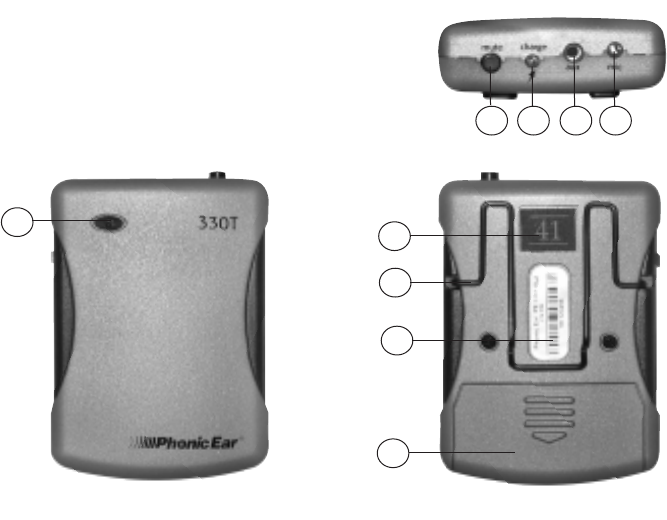
9
330T transmitter features
front back
1
3
5
2
4
top
6 7 8 9
3745 EL2 System User Guide 2/24/04 4:29 PM Page 15

10
10 on/off(chg) switch
1 on/off, low battery and charging
indicator light
2 channel number
5 battery compartment
3 belt clip
6 mute button
7 charging input jack (1.3mm)
9 microphone input jack (2.5mm)
8 auxiliary input jack (3.5mm)
side
10
4 serial number
on = Dim red light
low batt = Blinking light. When light
starts blinking there is approximately
1 hour of battery life left.
batt charging = Bright red light
improper charging = No light
3745 EL2 System User Guide 2/24/04 4:29 PM Page 16
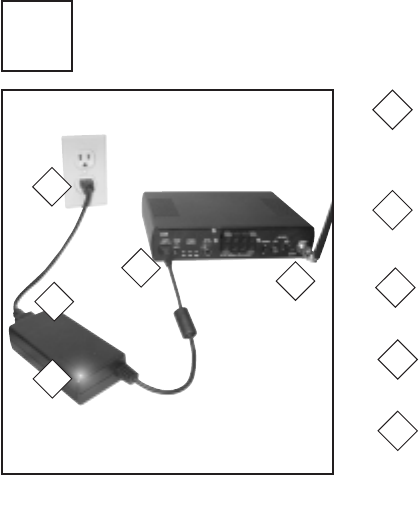
11
connecting power to 230R receiver
1
230R back
Plug power supply (040-7402-
105) into power port on back of
230R receiver
Plug power cord (AT0787) into
power supply unit (040-7402-105)
1
2
040-7402-105
1
3
2
AT0787
Plug power cord (AT0787) into
wall socket
3
4Check to see that green light is on,
indicating that unit has power
4
230R setup and operation
5
Attach antenna to antenna port on
back of 230R receiver
5
3745 EL2 System User Guide 2/24/04 4:29 PM Page 17
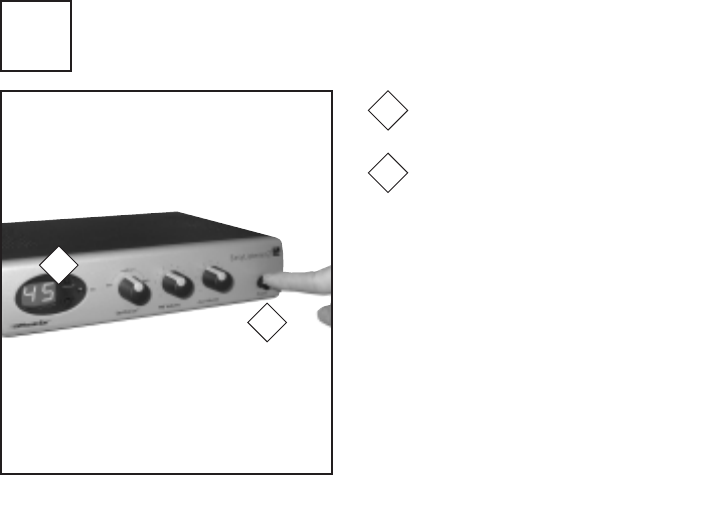
12
Push power button
Confirm that LED channel
display lights
turning on 230R receiver
2
1
2
1
2
3745 EL2 System User Guide 2/24/04 4:29 PM Page 18
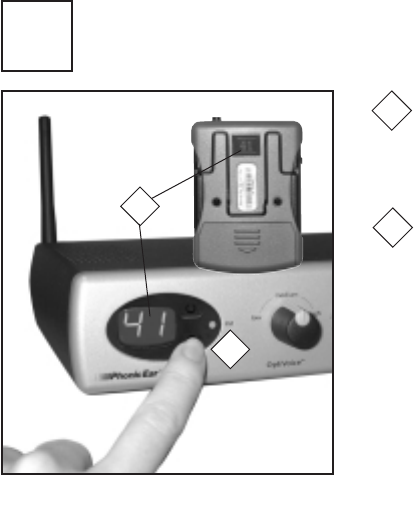
13
Push up or down channel adjust-
ment buttons to set channel on
receiver to match transmitter
channel
Make sure that receiver channel
matches transmitter channel
adjusting channel setting
3
1
2
1
2
330T
NOTE: There are 19 channels available in
the 216MHz frequency. See page 61 for a
complete list of Phonic Ear channel num-
bers and corresponding frequencies.
3745 EL2 System User Guide 2/24/04 4:29 PM Page 19
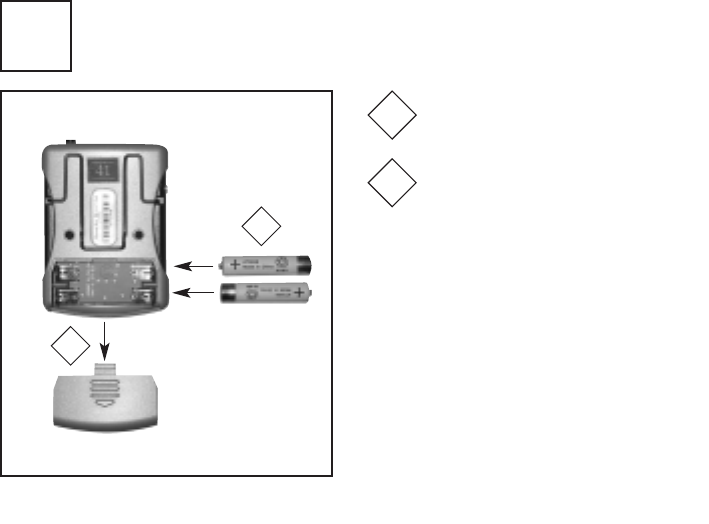
14
4inserting batteries
Push off battery compartment door
1
Insert rechargeable AAA NiMH
batteries included with system (or
alkaline batteries) into compart-
ment and replace door. Check
polarity markings to make sure
batteries are positioned correctly.
2
2
1
NOTE: Before the first use, batteries must
be charged for 12 hours. After that, we
recommend charging for 12 hours every
night for up to 12 hours of battery life.
330T setup and operation
3745 EL2 System User Guide 2/24/04 4:29 PM Page 20
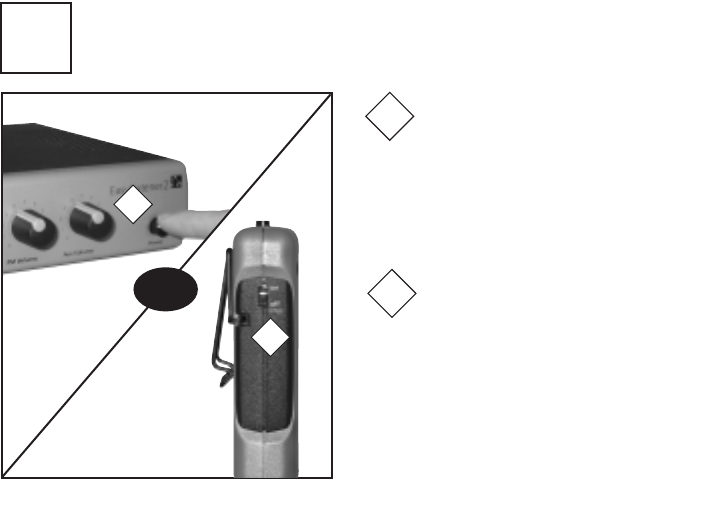
15
5a charging batteries
Do not attempt to charge alkaline batteries. The fail safe charging
system will not allow alkaline batteries to be charged.
Push power button to turn 230R
receiver off.
1
Switch transmitter power to
off (chg) position
2
1
then
2
NOTE: Sleep/standby power light
on receiver will remain lit in off
position.
3745 EL2 System User Guide 2/24/04 4:29 PM Page 21
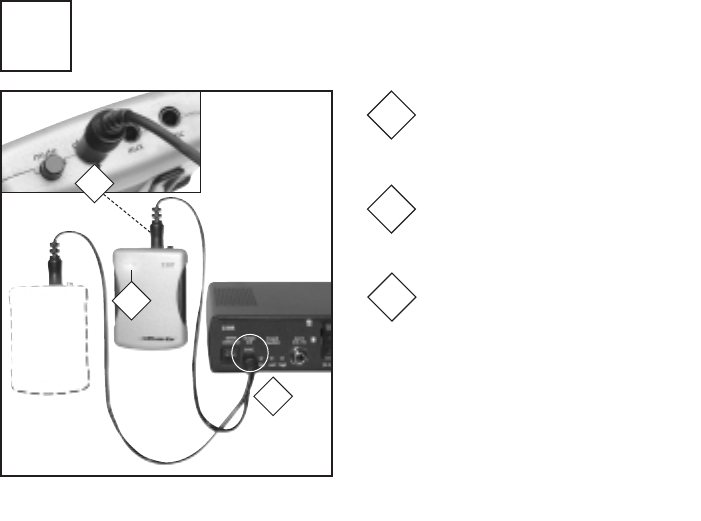
16
5b charging batteries (cont’d)
NOTE: We recommend charging for 12
hours every night for up to 12 hours of
battery life.
Charge only rechargeable NiMH batteries
from Phonic Ear.
230R (back)
Plug 300-6497-105 charging cord
into charge jack on top of 330T
body-worn unit(s)
3
Plug 300-6497-105 charging cord
into charge out jack on back of
230R receiver
4
4
300-6497-105
3
5Confirm that bright red LED dis-
play is lit
5
3745 EL2 System User Guide 2/24/04 4:29 PM Page 22
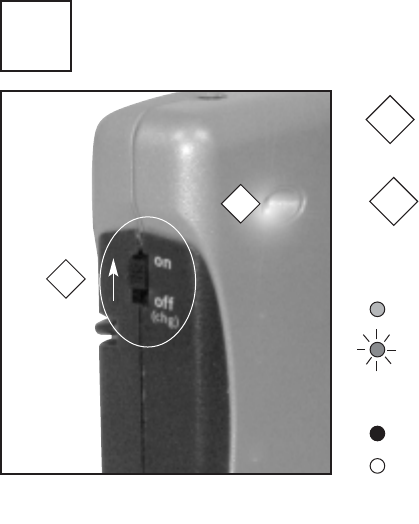
17
turning on 330T transmitter
6
Push power switch up to turn
transmitter power on
1
Confirm that red indicator light
is on
2
1
2
LED indicator light functions:
on = Dim red light
low battery = Blinking light. When
light starts blinking there’s approxi-
mately 1 hour of battery life left.
battery charging = Bright red light
improper charging = No light
3745 EL2 System User Guide 2/24/04 4:29 PM Page 23
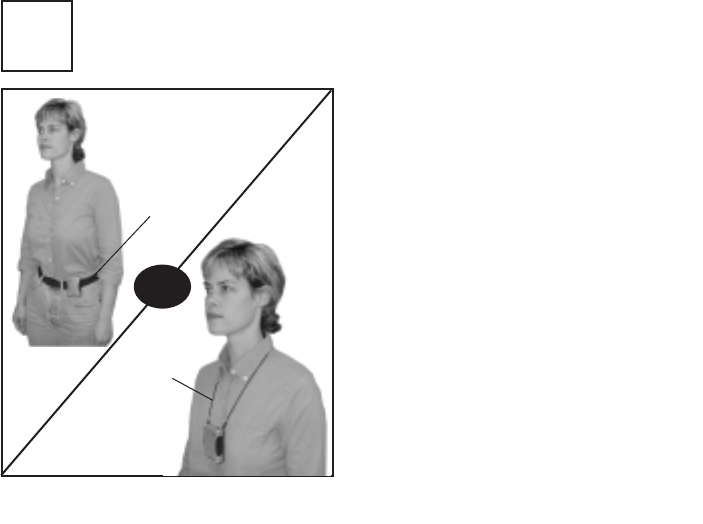
18
7wearing 330T transmitter
Clip to belt (AT0712), pocket, pants, etc.
or
Attach lavalier (AT0512-BK)* to clip on
the back of transmitter
AT0712
AT0512-BK
or
*Lavalier not included with system package
3745 EL2 System User Guide 2/24/04 4:29 PM Page 24
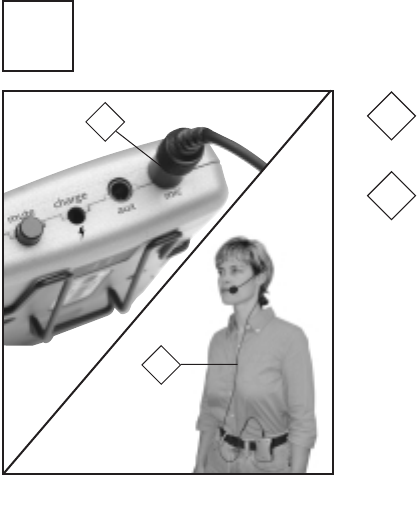
19
plugging in microphone
8
When wearing microphone,
keep antenna/cord as straight as
possible. Do not coil.
Plug microphone into mic jack on
330T unit
1
2
2
1
3745 EL2 System User Guide 2/24/04 4:29 PM Page 25
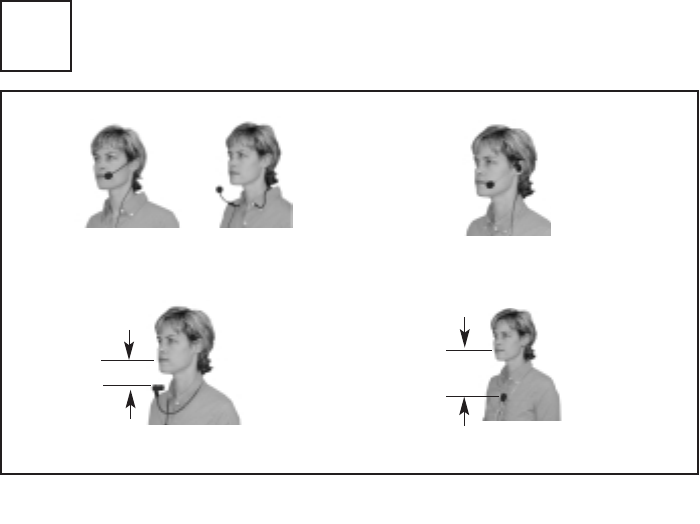
20
wearing microphone
(there are four microphone styles available for use with the EasyListener 2 system)
★★★★ = most compatible ★ = least compatible
9
AT0291-L directional lapel mic
15cm/
6in max.
optimum
AT0655 boom mic (two wearing options)
optional
AT0816 collar mic
7.5cm/3in
AT0814 earhook mic
Maximum distance from mic to mouth is 6 in/(15cm); 3 in/(7.5cm) is ideal.
★★★★ ★★★★
★★ ★★
3745 EL2 System User Guide 2/24/04 4:29 PM Page 26
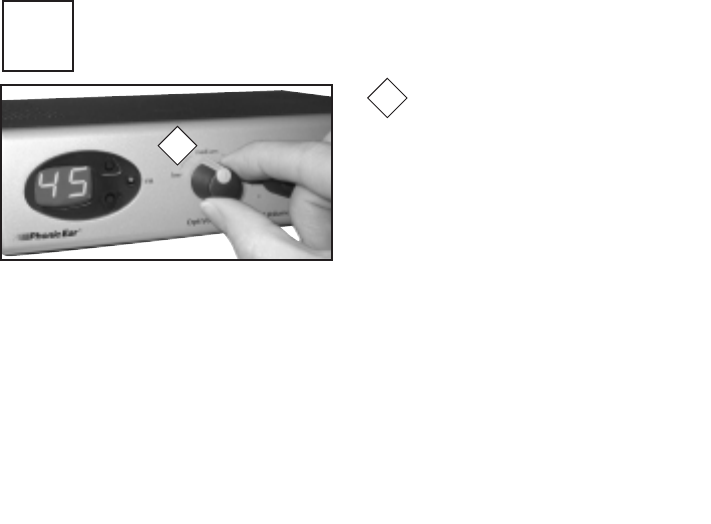
21
adjusting OptiVoice™ setting
1Set OptiVoice switch to medium
1
10
low: Recommended for use in low-noise situations and for most natural voice quality.
medium: Recommended for everyday use. Best setting for average classrooms where low-
medium noise levels are present.
high: Recommended for use in high noise levels. Helps to ensure top comprehension
during critical tasks such as test-taking or hearing impaired instruction.
NOTE: With each increase in level, there is an increase of approximately 3dB in gain
(volume). This may require you to decrease your volume setting to avoid potential micro-
phone/speaker feedback.
OptiVoice is a 3-position switch that automati-
cally adjusts the sound quality of the primary
speaker’s voice. It allows teachers to shape the
sound of their voice and helps to ensure maxi-
um speech clarity in low, medium and high
noise levels.
3745 EL2 System User Guide 2/24/04 4:29 PM Page 27
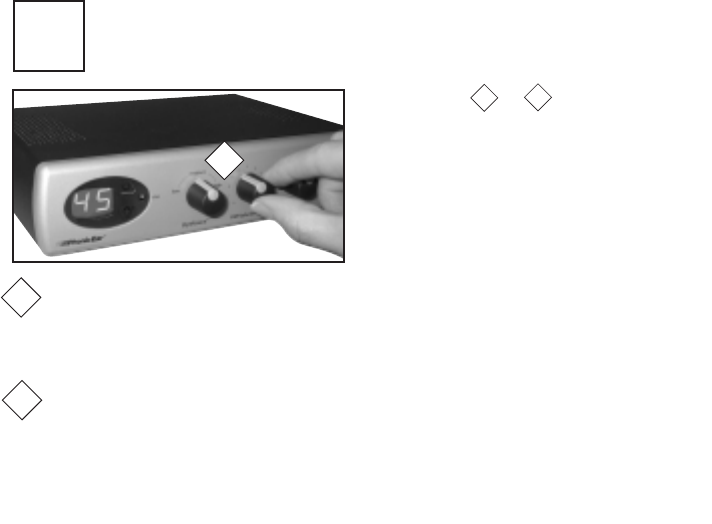
22
Follow steps or below to adjust FM
volume setting to proper level. Two people are
needed to set the volume level. It is difficult to
hear your own voice and make adjustments to it.
setting FM volume
11
1
1
With a sound level meter - Take a level reading in the “A” setting in the center of the
room during normal classroom activity, and another reading of the teacher's amplified voice
(without the class activity). The level of the teacher's voice should be set between 10-15
decibels above room noise level.
Without a sound level meter - First, ask someone other than yourself (if you are the
teacher) to listen to the amplified voice and make volume adjustments. An ideal volume level
is achieved when the listener can hear the amplified voice at a comfortable level and the vol-
ume level from the speaker and teacher’s mouth is comparable. If you can hear yourself
through the loudspeakers, the volume setting is too high and should be decreased
NOTE: The average volume setting is
between 4–5, but may change depending
on room acoustics and noise level.
2
12
3745 EL2 System User Guide 2/24/04 4:30 PM Page 28
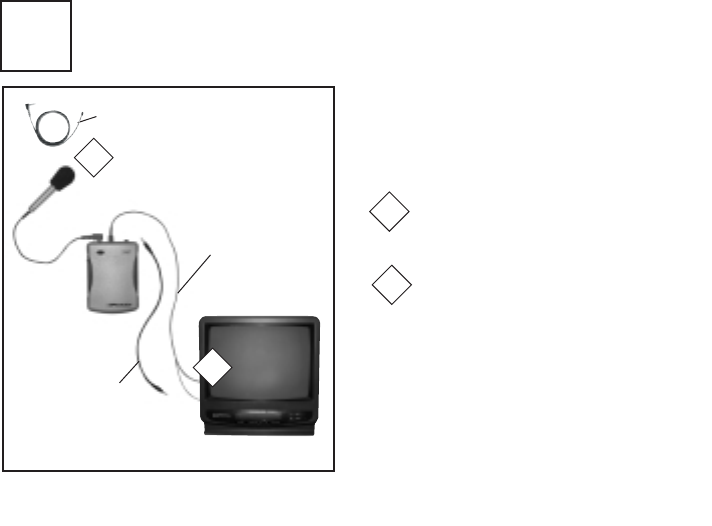
23
connecting CD, TV and other audio sources (optional)
Plug in microphone or external
antenna (AT0529A)
1
1
12 330T transmitter aux-in
300-6332-107
(3.5mm – dual RCA)
TV
Connect 330T to auxiliary sound
source using either the 300-6332-107
cord or the 384-01-210-08 cord
2
The 330T aux in jack allows transmis-
sion of an external audio source such as a
CD player, TV, VCR, or computer.
NOTE: OptiVoice will affect the sound
transmitted through the 330T transmitter.
Set the OptiVoice to low position for
most faithful reproduction of music, etc.
OR
384-01-210-08
(3.5mm –3.5mm)
2
AT0529A
(antenna)
OR
3745 EL2 System User Guide 2/24/04 4:30 PM Page 29
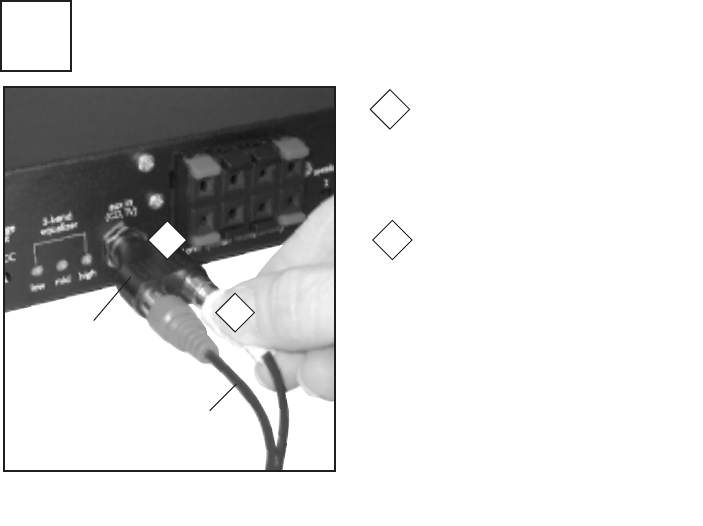
24
connecting CD, TV and other audio sources (optional)
For most connnections from CD
player, TV, stereo or other audio
sources, insert aux-in adaptor plug
(310-2544-1342) into aux in port
1
1
13 230R receiver aux-in
310-2544-1342
AT0702-25
Connect audio source to adaptor
plug using AT0702-25 (optional
accessory –not included with sys-
tem. See accessory list on page 55)
2
2
3745 EL2 System User Guide 2/24/04 4:30 PM Page 30
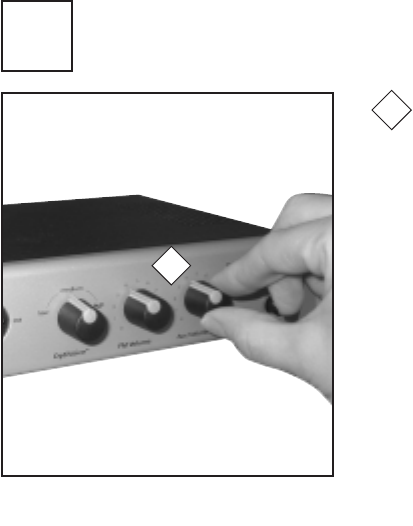
25
adjusting aux volume control
1
1
NOTE: OptiVoice does not affect aux
sound.
Turn aux volume control to adjust
CD, TV, stereo and other audio
sources plugged into aux in.
Depending on setup, you may have
to adjust volume of external audio
source.
14
3745 EL2 System User Guide 2/24/04 4:30 PM Page 31
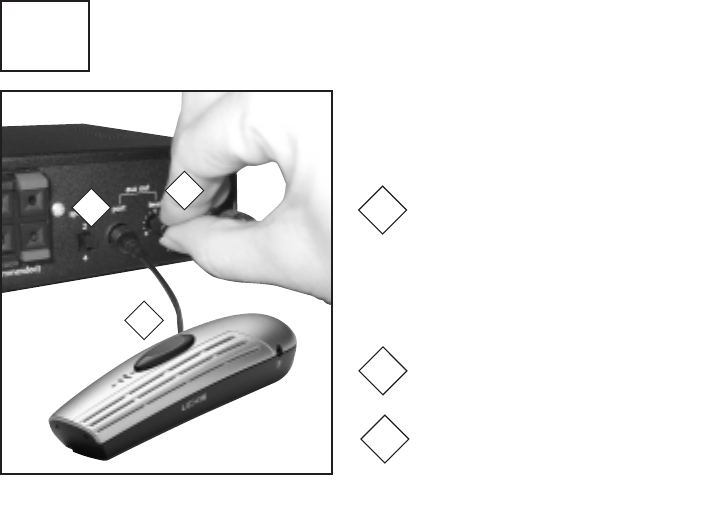
26
rebroadcasting to other receivers
15a
Adjust level setting for transmitter
using compatibility chart on follow-
ing page
3
1
Using AT0805 cord, attach
transmitter to aux out port
2
2Using AT0805 cord, attach
3.5mm end of cord into aux in port
of transmitter. NOTE: (Lexis unit
shown here. See chart on next page
for list of compatible products and
input adaptor plug sizes. Adaptor plug
310-2544-1341 may be required).
1
3
auxiliary output
The auxiliary output feature allows transmis-
sion, or rebroadcasting of the primary teacher’s
voice directly to a student’s personal FM sys-
tem, regardless of their channel or frequency.
3745 EL2 System User Guide 2/24/04 4:30 PM Page 32
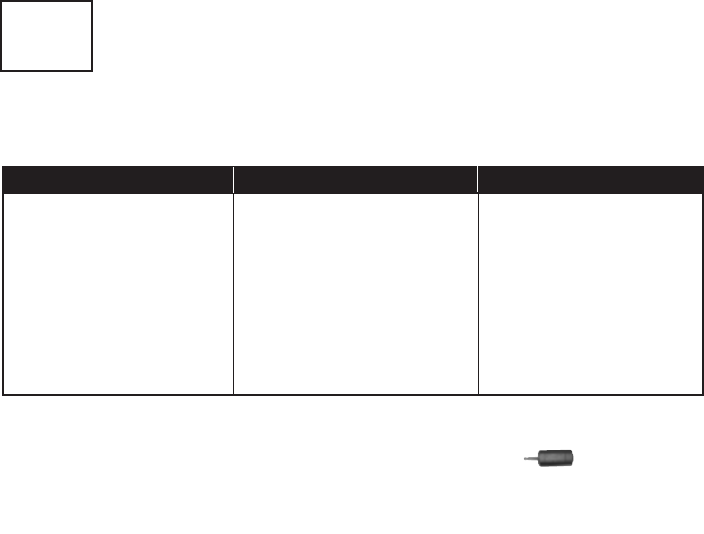
27
aux out transmitter compatibility chart and level setting guide
15b
Ouput range: The range of the aux out level control is 0V–1.0Vrms, linear
* For transmitters with a 3.5mm jack size, simply attach the transmitter to the AT0805 aux out accessory
cord. For 2.5mm products, use the aux out adapter plug (310-2544-1341)
† Requires special adaptor cord provided by Phonak
NOTE: Common transmitters and recommended level settings are shown below. Because the
level control is universal, other transmitters not listed below may be used as well – simply
adjust the aux out level control until the receiver wearer hears a strong distortion-free signal.
product name/part aux in jack size aux out level setting
Easy Listener 330T 3.5mm 2
Sprite 300TS 3.5mm 2
Sprite 300TS-216 3.5mm 2
Solaris 571T 3.5mm 5
Lexis 871T transmitter 3.5mm* 2
Phonak Campus TX5 3.5mm* 2
Phonak HandyMic TX3 3.5mm*† 2
Phonak MicroVox TX2 2.5mm 2
3745 EL2 System User Guide 2/24/04 4:30 PM Page 33
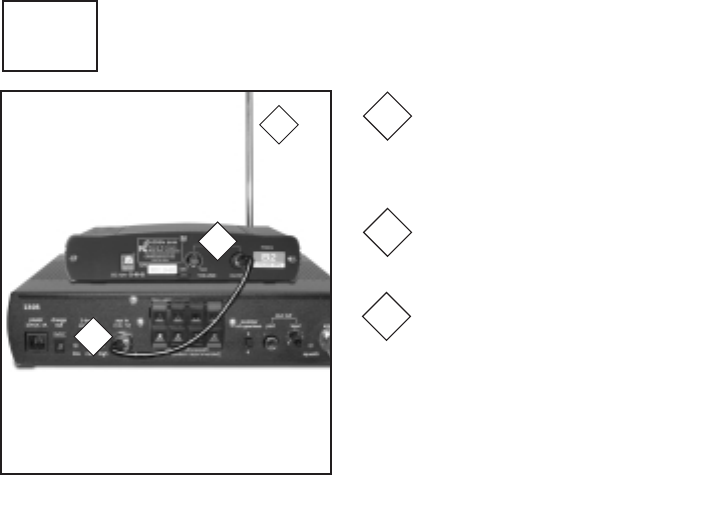
28
team-teaching with 211 receiver and handheld
microphone system
211R (back)
230R (back)
Connect one end of the AT0573-1
cable to Output jack on back of
211R unit
1
2
2
1
Connect the other end to the
aux in jack on back of the 230R
receiver
16a
3
3Extend 211R receiver antenna
3745 EL2 System User Guide 2/24/04 4:30 PM Page 34
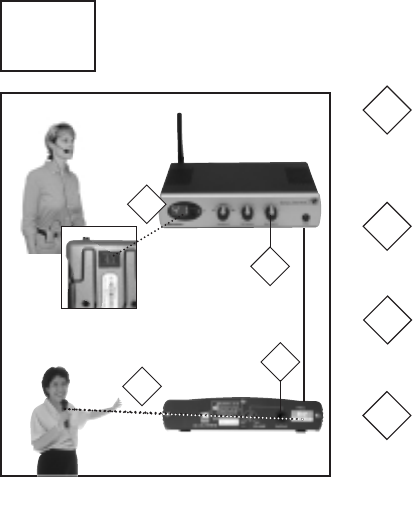
29
using 31HT handheld microphone
211R (back)
second teacher,
or student
230R (front)
No channel change is necessary on
the 211R and handheld mic – they
are factory set to match
Make sure that channel number
indicated on front of 230R receiv-
er matches channel number on the
back of 330T unit
4
5
first teacher
330T (back)
5
16b
Adjust the Aux Volume control
on front of 230R to proper level
7
7
AT0573-1
Set Volume control on back of
211R to approximately 1/3of the
way to it’s highest level setting
6
6
4
3745 EL2 System User Guide 2/24/04 4:30 PM Page 35
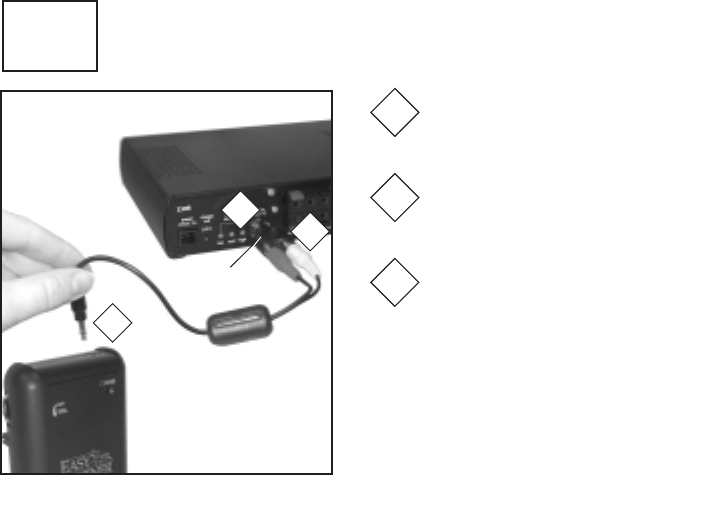
30
team-teaching with body-worn personal receiver &
transmitter units
Insert aux-in adaptor plug (310-
2544-1342) into aux in port on
back of 230R
1
Connect aux-in adaptor cord (300-
6332-107) to adaptor plug. (Match
red to red and white to white.)
2
300-6332-107
1
3
receiver
17a
NOTE: Second teacher should be wearing a
transmitter on same channel as receiver (see
diagram on next page)
*
*If a different receiver is used, a different
adaptor cord may be required.
310-2544-1342
2
Plug other end of aux-in adaptor
plug into aux jack on body-worn
receiver
3
3745 EL2 System User Guide 2/24/04 4:30 PM Page 36
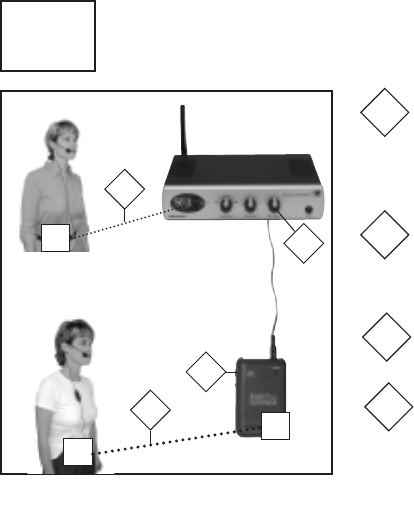
31
team-teaching with body-worn personal receiver &
transmitter units (cont’d)
First Teacher
Make sure that channel number
indicated on front of 230R receiv-
er matches channel number on the
back of 330T unit
3
Second Teacher*
Make sure that channel number
indicated on receiver matches
channel number on the transmitter
4
second teacher
4
230R (front)
first teacher
3
41
receiver
32
transmitter
330T
32
17b
Set volume level on team-teaching
receiver to 2/3max (6 -7 out of 10).
5
Set aux volume on 230R to
comfortable level (usually 4 -5).
6
6
5
* Refer to page 32 for channel pair combinations not
recommended with a 72MHz system.
3745 EL2 System User Guide 2/24/04 4:30 PM Page 37
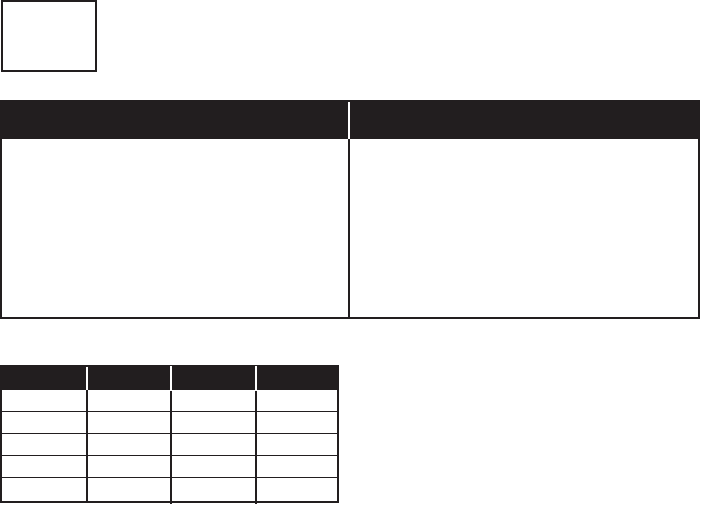
32
transmitters 300R 571R 575R
300T •••
300TS •••
300TS-216
330T
571T •••
possible Phonic Ear transmitter/receiver combinations:
72MHz & 216MHz channel pair combinations not
recommended for team teaching operation
17c
72MHz band frequency 216MHz band frequency effected
72.025MHz (Ch1) 216.075MHz (Ch42)
72.075MHz (Ch2) 216.225MHz (Ch45)
72.125MHz (Ch3) 216.375MHz (Ch48)
72.175MHz (Ch4) 216.525MHz (Ch51)
72.225MHz (Ch5) 216.675MHz (Ch54)
72.275MHz (Ch6) 216.825MHz (Ch57)
72.325MHz (Ch7) 216.975MHz (Ch60)
3745 EL2 System User Guide 2/24/04 4:30 PM Page 38

33
transmitters that can be used with 230R receiver
transmitter compatible performance accessory comments
rating needed
18
a) Lexis requires the use of AT0655 boom mic
b) May require use of external antenna for better
range (389-02-120-02)
c) set microphone to omni mode
d) set sensitivity level to high
330T-216 ✔ ★★★★ none
EasyListener 2
300TS-216 ✔ ★★★★ none
Sprite
Lexis transmitter ✔ ★★★ ✔
(as mic)
Phonak
Handymic TX3 N/A N/A N/A
(as mic)
Phonak ✔ ★★★ ✔
Campus S TX5
Phonak ✔ ★★★ ✔
MicroVox TX2
a) omni mic has extreme feedback issues
b) recommend use of external boom mic
from Phonak
recommend boom mic
a) built-in mic has high level of feedback
b) requires use of external mic, which the
Handymic will not accommodate
★★★★ = most compatible ★ = least compatible
(no adaptor
cord required)
3745 EL2 System User Guide 2/24/04 4:30 PM Page 39
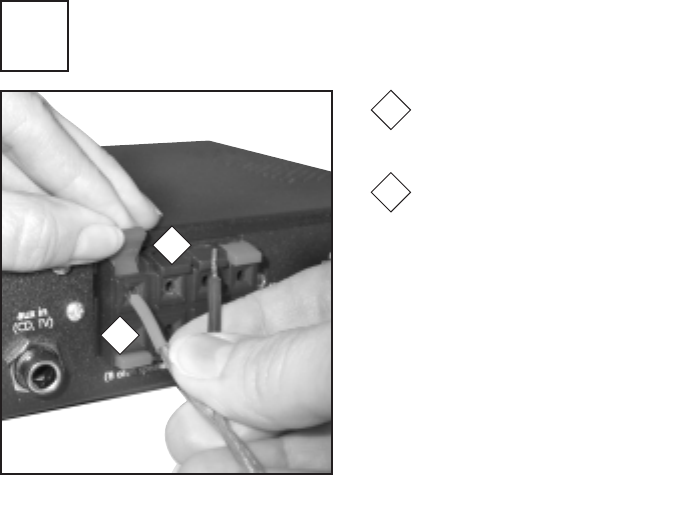
34
connecting speakers to 230R
19
NOTE: Use at least 18 GA Plenum
speaker wire (included with system)
230R back
Lift speaker cable connector tab
Insert exposed cable wire as far as
it will go into connector hole (red
to red; black to black), then push
tab down to secure cable. Pull on
cable slightly to make sure connec-
tion is secure.
1
2
1
2
speaker setup
3745 EL2 System User Guide 2/24/04 4:30 PM Page 40
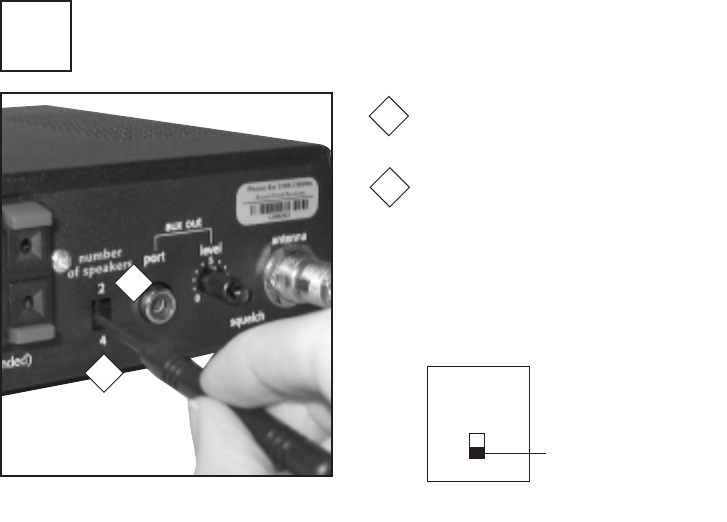
35
setting number of speakers
Verify number of speakers switch
is set to 4if using 4 speakers
Set switch to 2if using cluster ceiling
speaker or a 1-3 daisy-chaining
speaker configuration
Selecting the proper setting
allows for:
• optimal power distribution and
optimal system performance
1
1
20
2
2
number
of speakers
2
4
Verify the number of
speakers switch is set
to 4on back of 230R
3745 EL2 System User Guide 2/24/04 4:30 PM Page 41
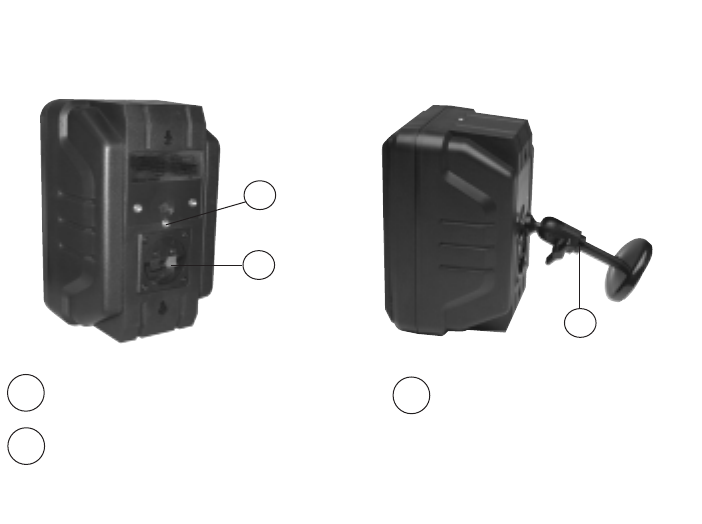
36
470-2856-119 compact speaker features
speaker with wall bracket
2 speaker wire input terminals
1 bracket mounting hole
back
2
3
1
3 wall mount bracket
(470-7329-103)
Consult bracket mounting guide included
with bracket packaging for complete
installation instructions.
3745 EL2 System User Guide 2/24/04 4:30 PM Page 42
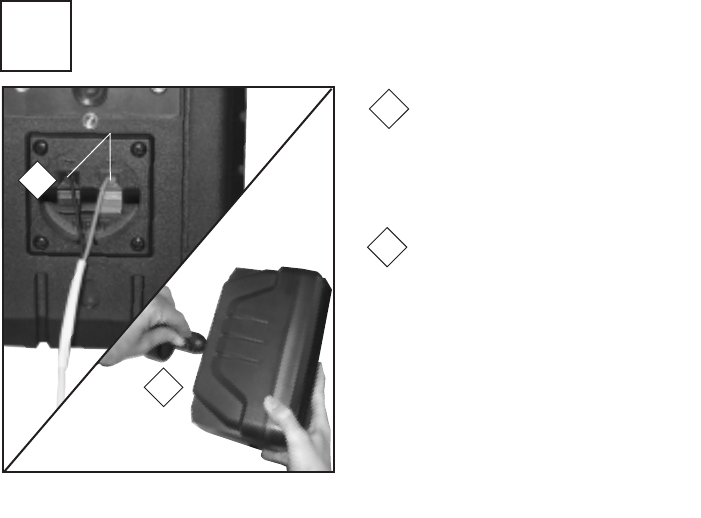
37
compact speaker hookup and adjustment
Loosen thumb screw on side of
bracket to adjust speaker position.
Tighten screw to hold speaker in
desired position.
1Attach AT0581 speaker cable to
back of speaker. Insert red-tipped
cable into red speaker connector
and black-tipped cable into black
speaker terminal.
2
Red to Red and
Black to Black
AT0581
21
NOTE: Pull on cable slightly to make sure
connection is secure.
1
2
3745 EL2 System User Guide 2/24/04 4:30 PM Page 43
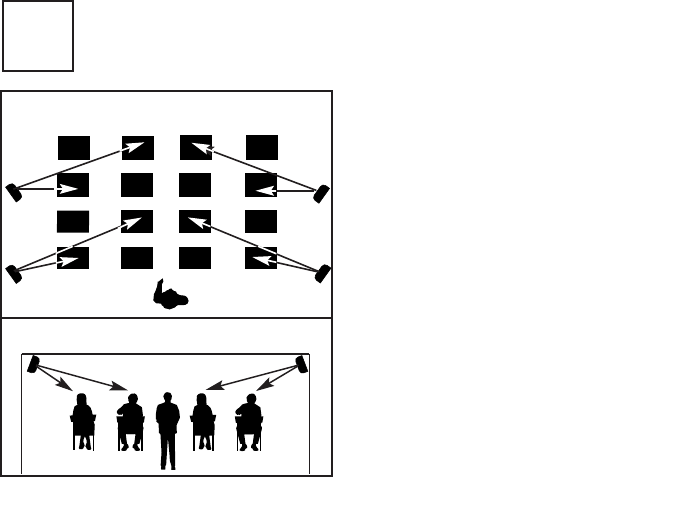
38
where to mount compact wall speakers
Based on your classroom acoustics and seating
arrangement, speaker placement will vary.
• For an average sized classroom, 4 speakers
are recommended
• Mount on walls, ceiling beams, or other
structure
• Place speakers as high up as possible
• Aim speakers down toward listeners’ faces.
• The farthest listener each speaker can
serve should be less than twice as far
away as the closest listener. (D2<2D1
in diagram)
For optimal speaker placement, download our
sound field wizard software from our web
site at www.phonicear.com.
top view
D2
D1
D2
front view
D1
D2D2
D1D1
D1D1
D2D2
ceiling
wall
wall
ceiling
22
3745 EL2 System User Guide 2/24/04 4:30 PM Page 44
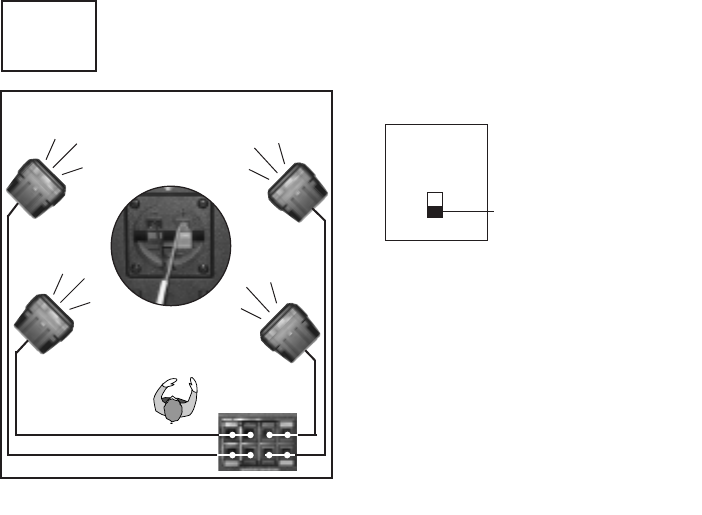
39
standard four-speaker setup
For other speaker connection options, see page 49
• For average-sized rooms (30 x 30 ft)
230R speaker
terminals
23a
number
of speakers
2
4
NOTE: When installing compact wall or
ceiling speakers, keep cord flush to wall
and away from foot traffic.
teacher
speaker cable hookup
(back of each speaker)
1
2
3
4
Verify the number of
speakers switch is set
to 4on back of 230R
• Sound will not come through until all
speakers have been hooked up.
3745 EL2 System User Guide 2/24/04 4:30 PM Page 45
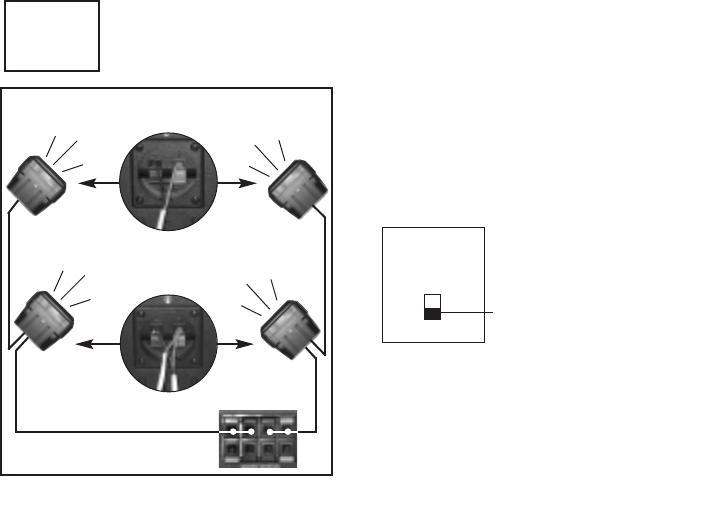
40
standard four-speaker daisy-chaining option
For advanced speaker connection options, see page 49
• Daisy-chaining allows setup with shorter
cable lengths
• For optimum performance, daisy chain
speakers in pairs: e.g. speakers 1-2, then
3-4 rather than 1-2-3-4 separately
23b
number
of speakers
2
4
230R speaker
terminals
double speaker cable hookup
(back of speaker 1 & 3)
1
2
3
4
NOTE: Be sure to plug one speaker set
on right, and one speaker set on left side
of terminal.
Verify the number of
speakers switch is set
to 4on back of 230R
single speaker cable hookup
(back speaker 2 & 4)
3745 EL2 System User Guide 2/24/04 4:30 PM Page 46
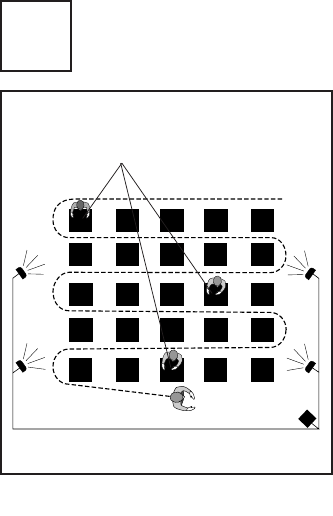
41
walk, talk, and listen to quality
(Initial setup only; reposition speakers if necessary.)
24
Ask another person to assess volume
levels from front and back of room
while you speak
top view
• Make certain that speakers are angled
down toward student seating area.
• Adjust FM volume setting as necessary
3745 EL2 System User Guide 2/24/04 4:30 PM Page 47
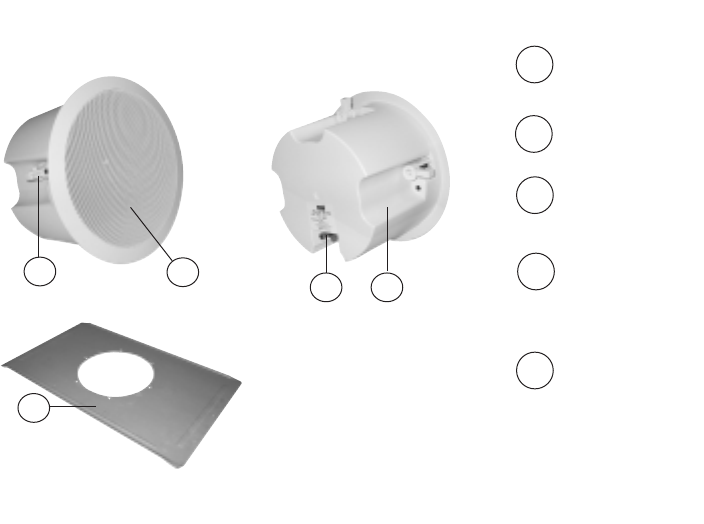
42
3 speaker input
terminals
AT0806 distributed ceiling speaker features
front 1 mounting tabs
1
back
3
2
2 speaker grill
5 470-7347-106
metal tile bridge
5
44 attached speaker
back enclosure
(back can)
NOTE: Tile bridge must be
used with acoustic drop ceil-
ing installations. See instruc-
tion sheet enclosed with ceil-
ing speakers for complete
installation instructions.
3745 EL2 System User Guide 2/24/04 4:30 PM Page 48
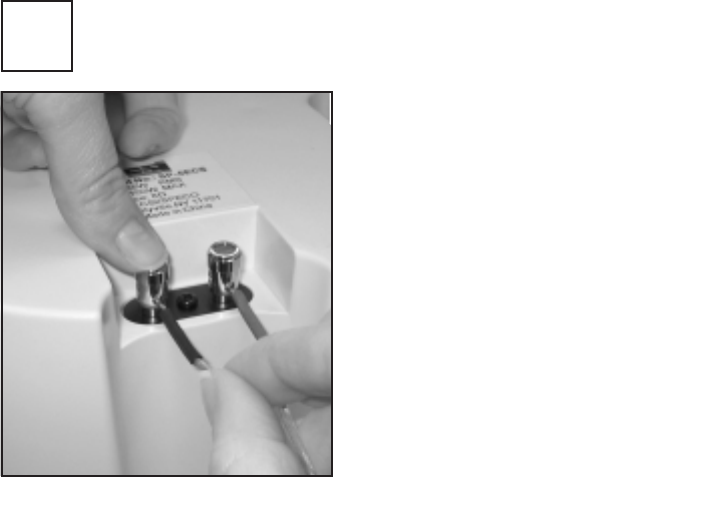
43
attach speaker wires
Attach the speaker wires to the speaker
terminals by pressing in each compression
terminal to reveal an “eye”, inserting the
wire, and releasing the terminals to lock
the cable in place.
NOTE: Connect red to red and black
to black.
25
3745 EL2 System User Guide 2/24/04 4:30 PM Page 49
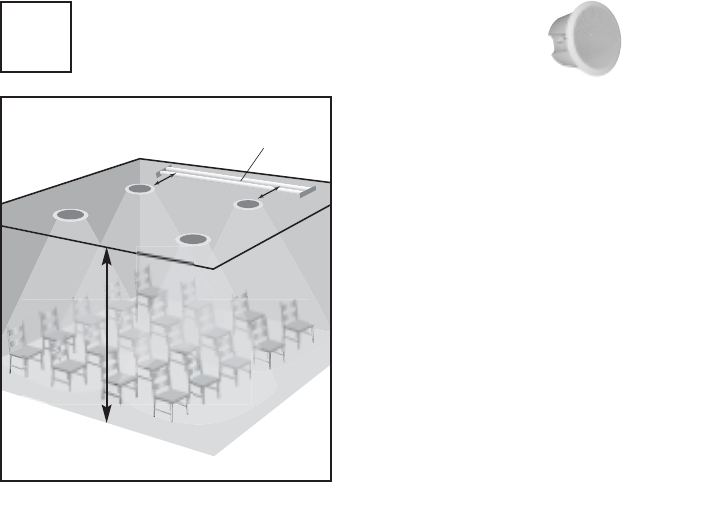
44
fluorescent
lighting transformer
>30cm/1ft
where to mount distributed ceiling speakers
• Space speakers evenly over listening area
• >3m/10ft minimum ceiling height
recommended
• >30cm/1ft distance from fluorescent
lighting transformer is recommended
26
>3m/10ft
3745 EL2 System User Guide 2/24/04 4:30 PM Page 50
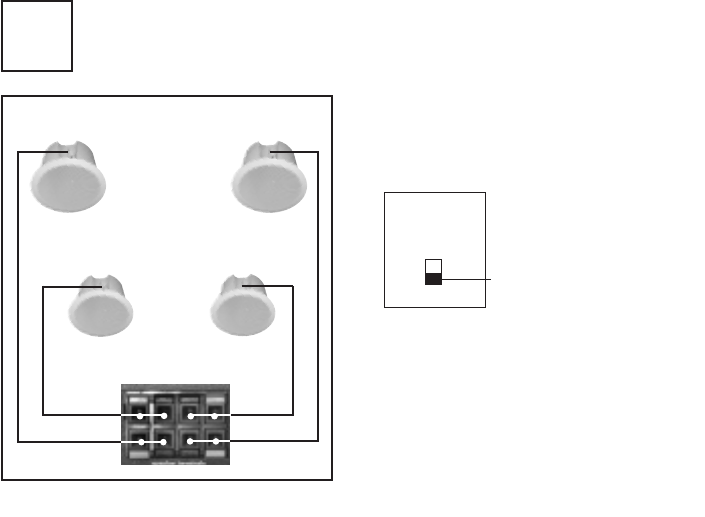
45
distributed ceiling speaker wire hookup
• Wiring should go above ceiling tile
NOTE: Use at least 18 GA Plenum
speaker wire included with system.
27
number
of speakers
2
4
230R speaker
terminals
Verify the number of
speakers switch is set
to 4on back of 230R
NOTE: Sound will not come through until
all speakers have been hooked up.
1
2
3
4
3745 EL2 System User Guide 2/24/04 4:30 PM Page 51
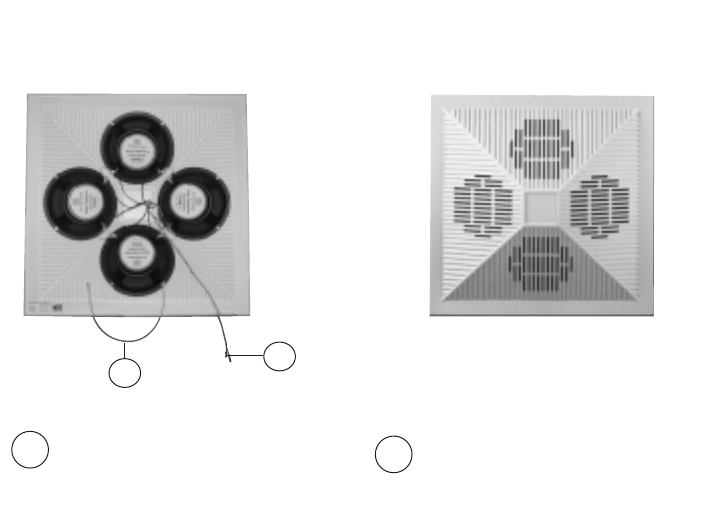
46
bottom
top
AT0664 cluster ceiling speaker features
2 speaker cable crimp connectors
1 safety wire
12
3745 EL2 System User Guide 2/24/04 4:30 PM Page 52
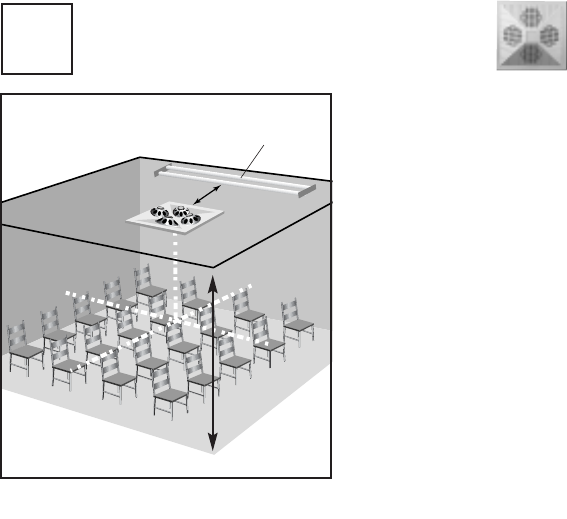
47
fluorescent
lighting transformer
>30cm/1ft
where to mount cluster ceiling speaker
• Center speaker over listening area
• >3.7m/12ft minimum ceiling height is
recommended
• >30cm/1ft distance from fluorescent
lighting transformer is recommended
28
>3.7m/12ft
3745 EL2 System User Guide 2/24/04 4:30 PM Page 53
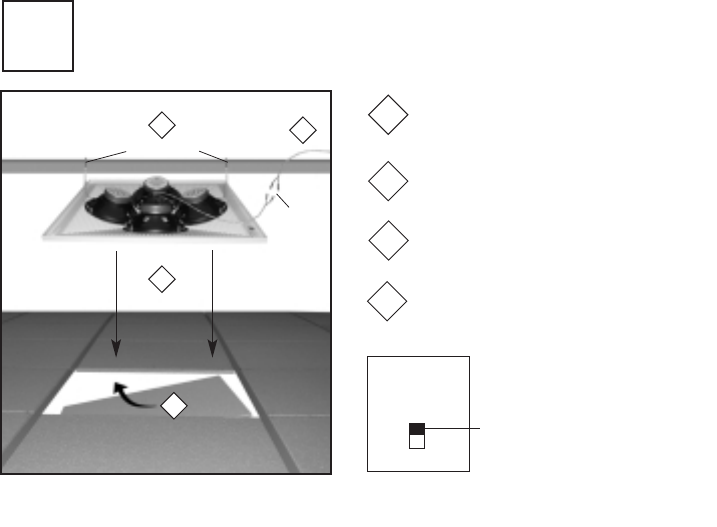
48
cluster ceiling speaker setup
Remove 60 x 60 cm/2 x2 ft
ceiling tile
Lower speaker into space
Secure safety wires
Connect and crimp speaker cable
(run cable along wall)
beam
safety wires
Red to Red/
Black to Black
1
2
3
4
1
2
34
29
number
of speakers
2
4
Set number of speakers
switch to 2on back of 230R
3745 EL2 System User Guide 2/24/04 4:30 PM Page 54
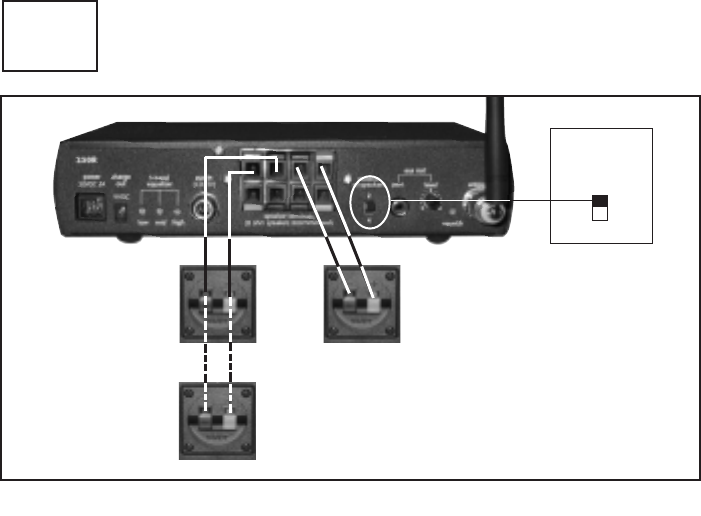
49
daisy-chaining with 3 speakers
230R back
compact speaker
input terminals
shown here
30a
1Set number
of speakers
switch to 2
2
3
number
of speakers
2
4
advanced system setup
Be sure to connect
speaker wires to
the designated
terminals for best
performance and
sound distribution
3745 EL2 System User Guide 2/24/04 4:30 PM Page 55
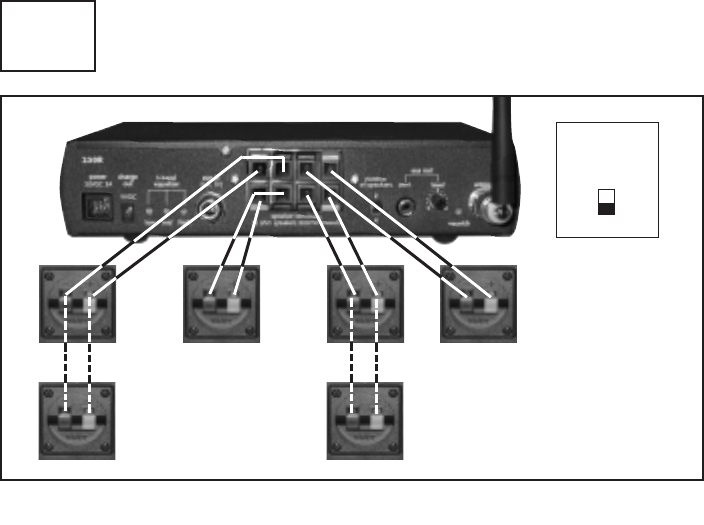
50
daisy-chaining with 6 speakers
230R back
compact speaker
input terminals
shown here
30b
number
of speakers
2
4
Set number
of speakers
switch to 4
Be sure to connect
speaker wires to
the designated
terminals for best
performance and
sound distribution
3745 EL2 System User Guide 2/24/04 4:30 PM Page 56
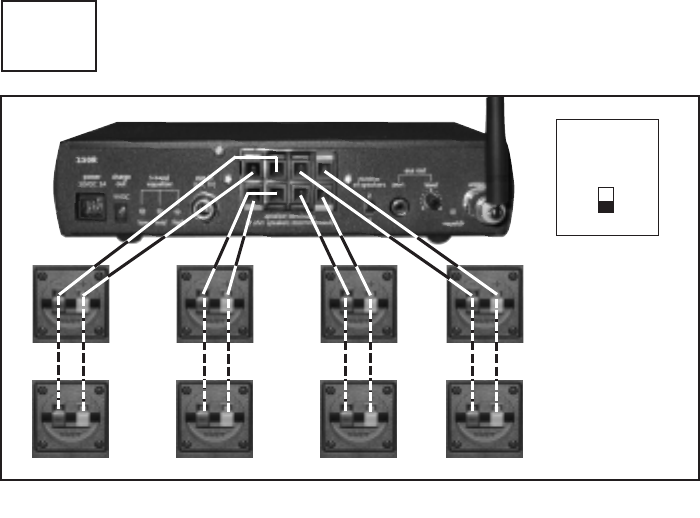
daisy-chaining with 8 speakers
230R back
compact speaker
input terminals
shown here
30c
Be sure to connect
speaker wires to
the designated
terminals for best
performance and
sound distribution
number
of speakers
2
4
Set number
of speakers
switch to 4
51
3745 EL2 System User Guide 2/24/04 4:30 PM Page 57
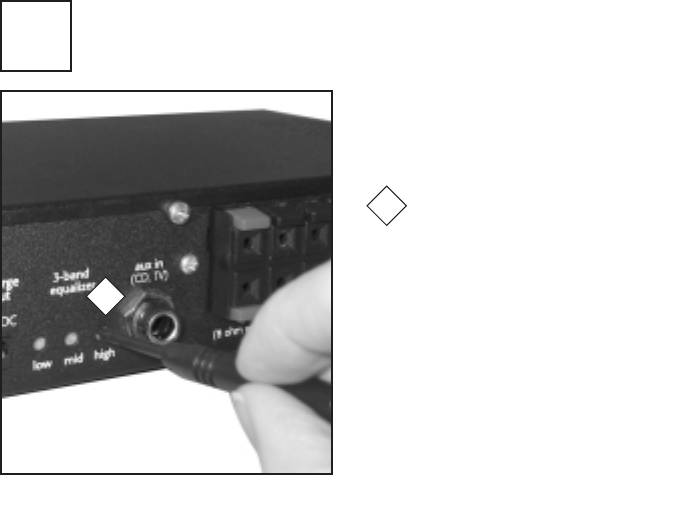
52
adjusting 3-band equalizer
(This setting should be adjusted by sound professionals ONLY)
31
Use screwdriver to adjust the low,
mid and high settings. Turn to the
right to add base, mid and high
tones. Turn left to decrease.
A properly adjusted equalizer opti-
mizes the system’s sound quality and
reduces feedback.
Making improper adjustments could
result in a degradation in sound qual-
ity and performance.
1
1
ATTENTION: If you are not a sound profes-
sional, we do not recommend that you alter
the 3-band equalizer settings.
3745 EL2 System User Guide 2/24/04 4:30 PM Page 58
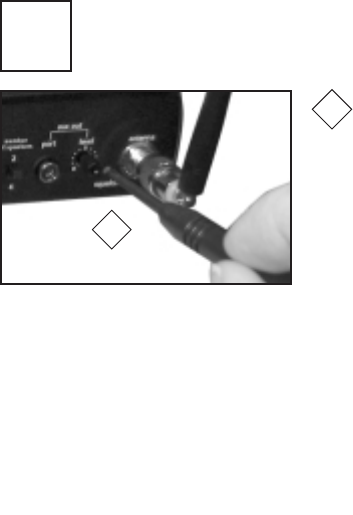
53
adjusting squelch
(This setting should be adjusted by sound professionals ONLY)
32
Using a screwdriver turn the control slightly to
the left (counter clockwise) to increase the sys-
tem's range and to the right (clockwise) to
decrease the system's range.
1
The squelch setting increases or decreases the sys-
tem’s range by disabling the receiver audio when
the transmitter signal is below the threshold point.
It also allows the ability to re-use a channel, pro-
vided that systems coverage area is installed more
than 200ft apart (indoors). For best results, ask someone to help you by wearing the trans-
mitter and walking away from the base station receiver towards the perimeters of the room.
When you begin to hear noisy static, you know you've reached the system's internal range
limits. Increase or decrease the range slightly, and re-test by repeating this step. (In most
cases the system's range will go well beyond the typical classroom.)
If noise or signal interference persists, make sure systems in adjacent classrooms are turned
off. Re-test range and set squelch for the minimum system range to reduce external interfer-
ence. Contact Phonic Ear Service if extra assistance is required.
1
3745 EL2 System User Guide 2/24/04 4:30 PM Page 59
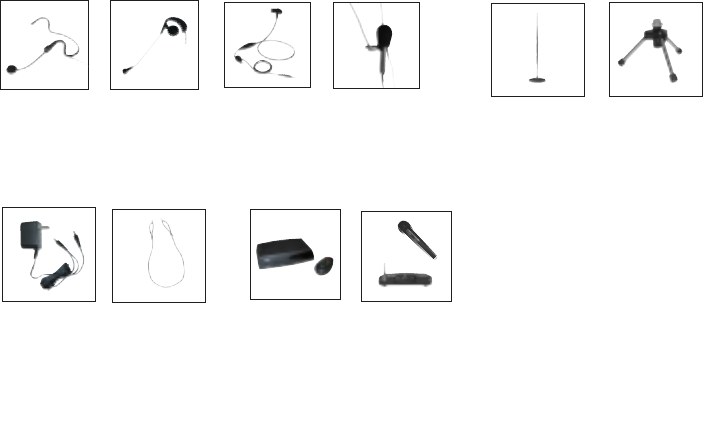
54
microphone styles
optional accessories (not included with system)
211
wireless microphone
system for team-
teaching and student
pass-around use
AT0749
wall transformer/
charger for 330T
AT0512-BK
lavalier cord
AT0814
earhook microphone
AT0655
behind-the-neck
boom microphone
AT0291-L
directional microphone
with lavalier cord
transmitter accessories
AT0801
aux-box (adds four
additional audio
inputs)
AT0579
speaker floor stand
(requires AT0582
stand adaptor)
AT0816
FM collar microphone
with mute switch
receiver accessories
speaker accessories
AT0579-T
table-top stand
(requires AT0582
stand adaptor)
3745 EL2 System User Guide 2/24/04 4:30 PM Page 60
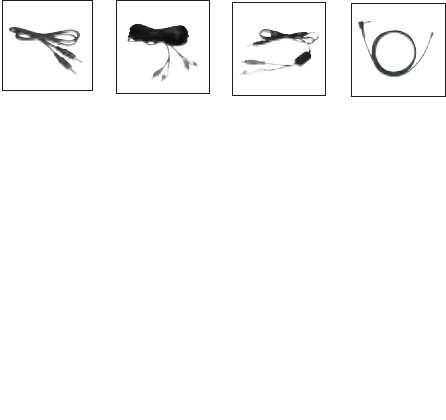
AT0529A
antenna (for use with
auxiliary input only)
384-01-210-08
aux-in adaptor cord
(3.5mm–3.5mm)
330T to external
audio, TV, VCR,
DVD, computer, etc.
AT0702-25
aux-in adaptor cord
(dual RCA– dual RCA)
230R to external audio,
TV, VCR, DVD, etc.
auxiliary input adaptor cords
300-6332-107
aux-in adaptor cord
(3.5mm – dual RCA)
330T to external audio,
or team-teaching
55
optional accessories (not included with system) cont’d
3745 EL2 System User Guide 2/24/04 4:30 PM Page 61

56
no FM reception (green FM indicator
light on front of receiver is not on)
• Verify the receiver is turned on
• Verify the transmitter is turned on (note that
red LED indicator light will be dim red)
• Verify the frequency number on the receiver
matches the frequency number on 330T
transmitter
• Verify transmitter batteries have been charged
• Verify batteries are inserted properly
• Verify that receiver antenna is connected
weak sound from speaker(s)
• Make sure AT0655 boom microphone (or
other microphone) is being worn correctly
•
Increase FM and/or Aux Vol control
• Reposition the microphone closer to the
speaker’s mouth
• Check that none of the speakers are blocked
or covered
• Verify that the speaker wires are properly con-
nected to 230R speaker terminals (reinsert each
one deep into terminal socket)
• Reposition speakers closer to the listeners
troubleshooting
3745 EL2 System User Guide 2/24/04 4:30 PM Page 62

57
troubleshooting (cont’d)
receiver is receiving a signal but no
sound is coming from speaker
• Verify microphone is connected properly to
transmitter and is working correctly
• Confirm that transmitter mute switch is in
off position (un-depressed)
feedback from speaker(s)
• Turn down the volume on the 230R receiver
• Reposition mic closer to mouth
• Make sure the person wearing the transmitter is
not too close to the speaker(s)
• Make sure AT0655 boom microphone (or
other mic) is being worn correctly
speaker(s) is picking up FM interfer-
ence or hum
• Check to make sure no other wireless systems
are operating on similar frequencies
• Check to make sure the system is placed more
than 6ft from a computer
• Check to make sure metal objects are not
placed too close to transmitter or speaker(s)
(i.e. jewelry, metal shelves)
3745 EL2 System User Guide 2/24/04 4:30 PM Page 63

58
caring for your system
cleaning
Clean as needed, using a soft, damp cloth.
other important notes
• Protect your sound field system from excessive
moisture, heat, and mechanical shocks.
• Clean with a soft damp cloth and remove the
batteries from the transmitter. Place the system
into the accessory/transmitter kit.
• The case bottom and top of the 230R and the
040-7402-105 receiver power supply can get
warm under normal operation.
• To protect the transmitter’s case front, position
it face down on a soft surface when removing
or inserting the batteries.
• Always dispose of old batteries in approved bat-
tery recycling bins. It may be illegal to dispose in
the trash. If you are not sure of proper disposal
method, please consult your local authority.
3745 EL2 System User Guide 2/24/04 4:30 PM Page 64

59
channel number frequency channel number frequency
41 . . . . . . . . . . . . . . . . 216.025 51 . . . . . . . . . . . . . . . .216.525
42. . . . . . . . . . . . . . . . . 216.075 52 . . . . . . . . . . . . . . . .216.575
43. . . . . . . . . . . . . . . . . 216.125 53 . . . . . . . . . . . . . . . .216.625
44. . . . . . . . . . . . . . . . . 216.175 54 . . . . . . . . . . . . . . . .216.675
45. . . . . . . . . . . . . . . . . 216.225 55 . . . . . . . . . . . . . . . .216.725
46. . . . . . . . . . . . . . . . . 216.275 56 . . . . . . . . . . . . . . . .216.775
47. . . . . . . . . . . . . . . . . 216.325 57 . . . . . . . . . . . . . . . .216.825
48. . . . . . . . . . . . . . . . . 216.375 58 . . . . . . . . . . . . . . . .216.875
49. . . . . . . . . . . . . . . . . 216.425 59 . . . . . . . . . . . . . . . .216.925
50. . . . . . . . . . . . . . . . . not available 60 . . . . . . . . . . . . . . . .216.975
EasyListener 2 channel numbers and corresponding frequencies
3745 EL2 System User Guide 2/24/04 4:30 PM Page 65

60
product specifications
receiving frequency 216MHz, synthesized (U.S./Canada)
frequency stability ±500Hz 0Oto 50O C
modulation FM narrow-band
AF frequency response 20Hz -20kHz, -3dB (Aux in)
70Hz -10kHz, -3dB (FM in)
power output 14W into 8Ω/28W into 4Ω
auxiliary input level 300mVrms (-10dBV) 0.25in stereo
auxiliary output 0-1Vrms adjustable via rear panel, RCA
aux input impedance 47kΩ
FM signal-to-noise > 63dB, A weighted
THD
< 3% @ 1kHz maximum output
nominal deviation ±5kHz
maximum deviation ±10kHz
squelch RSSI-type
squelch level adjustable via rear panel
power supply 20VDC @ 3A
charge port 5VDC, 200mA
base station receiver: 230R
user controls (front) on/off, FM volume, Aux volume,
OptiVoice, channel up/down
installer controls 3-band equalizer, squelch, speaker
configuration selector
displays 2 digit channel LED display and
LED for “FM signa”
dimensions (
W
x
H
x
D
)21.9 x 5.4 x 16.2 cm/
8.6 x 2.1 x 6.4 in
weight 1.11kg/2.45lb
case steel, powder coat finish
3745 EL2 System User Guide 2/24/04 4:30 PM Page 66

61
product specifications (cont’d)
speaker type Bass reflex;
8.9cm/3.5in woofer
2.5cm/1in soft-dome tweeter
impedance 8Ωnominal
continuous power 30W
peak power 80W
frequency response 65Hz to 20kHz -10dB
dimensions (
W
x
H
x
D
)12.7 x 22.2 x 14cm/
5 x 8.75 x 5.5 in
weight 1.75kg/3.86lbs
mounting wall mounting brackets provided
(tabletop/floor stands also available)
speaker wire AT0581 7.3m/24ft, 14.6m/48ft,
and 18.3m/60ft lengths available
sensitivity 88dB, 1W @ 1m
compact speakers: 470-2856-119
transmitting 216MHz, crystal controlled (U.S./Canada)
frequency
modulation FM narrow-band
operating range up to 50m/160ft
user controls off/on
push button mute switch
inputs/outputs 3.5mm auxiliary input jack
2.5mm microphone input jack
1.3mm charge jack
battery life 15Hr (AAA alkaline)
12Hr (AAA NiMH)
dimensions (
W
x
H
x
D
)5.9 x 8.2 x 2.0 cm/
2.3 x 3.3 x 0.8 in
weight 74.8g/2.64oz (with batteries)
case ABS plastic, painted
battery/power/ on (dim): power on
charge LED flashing: low battery – 1 hour life remaining
on (bright): charging
transmitter: 330T
3745 EL2 System User Guide 2/24/04 4:30 PM Page 67

62
speaker type coaxial: 6in woofer, .5in tweeter
impedance 8Ωnominal
sensitivity 90dB, 1W @ 1m
continuous power 35W
peak power 70W
frequency response 65Hz to 20kHz
dimensions (
DIA
x
D
)203 x 5.7 cm/9 x 2.25 in
weight 1.1kg/2.4lbs
mounting acoustic ceiling metal tile bridge
(470-7347-106)
speaker wire AT0581 7.3m/24ft, 14.6m/48ft,
and 18.3m/60ft lengths available
min ceiling height 3m/10ft
distributed ceiling speaker: AT0806
speaker type 4 full-range 20cm/8in speakers
impedance 8Ωnominal
sensitivity 96dB, 1W @ 1m
continuous power 40W
frequency response 30Hz to 15kHz
dimensions (
W
x
H
x
D
)16.5 x 14 cm/
6.5 x 5.5 in
weight 4.53kg/10lbs
mounting replaces 2ft x 2ft acoustic ceiling tile;
includes safety wire
speaker wire AT0581 7.3m/24ft, 14.6m/48ft,
and 18.3m/60ft lengths available
min ceiling height 3.7m/12ft
enclosure fire and smoke emission rated
cluster ceiling speaker: AT0664
product specifications (cont’d)
3745 EL2 System User Guide 2/24/04 4:30 PM Page 68

63
warranty
time period of warranty
This warranty will go into effect upon the date
of purchase and will stay in effect as long as
the instrument remains the property of the orig-
inal owner. EASYLISTENER 2™,VOCALIGHT™and
ONWAVE™have a 3-year warranty. All other prod-
ucts have a 1 year warranty.
what is covered by this warranty
Any electronic component, which because of work-
manship, manufacturing or design defects, fails to
function properly under normal use during the life of
this warranty will be replaced or repaired at no charge
for parts or labor, when returned to the factory
service center. Transportation in and out is paid by the
customer. If it is determined that repair is not
feasible, the entire unit may be replaced with an equiv-
alent unit upon mutual agreement of the
manufacturer and customer.
what is not covered by this warranty
This limited warranty does not apply to:
1. Malfunctions resulting from abuse, neglect
or accident
2.
I
nstruments connected, installed, used or adjusted
in any manner contrary to instructions provided
by the manufacturer
3. Consequential damages and damages resulting
from delay or loss of this instrument. The exclu-
sive remedy under this warranty is strictly limited
to repair or replacement as herein provided
4. Products damaged in transit unless investigated
by the shipper and returned to the warrantor
with the investigation report
5. Peripheral accessories as itemized within the
product specification sheet as applicable, when
such items are returned within 1 year from
original purchase
6. Batteries if applicable
3745 EL2 System User Guide 2/24/04 4:30 PM Page 69

64
warranty (cont’d)
Phonic Ear Inc. reserves the right to make changes in
the design or construction of any of its instruments at
any time without incurring any obligation to make any
changes whatsoever on units previously purchased.
This warranty is in lieu of all other expressed warranties.
All expressed and implied warranties will terminate upon
the expiration of this written warranty. No representative
or person is authorized to represent or assume for us any
liability in connection with the sale or use of our prod-
ucts other than as set forth above.
what to do if you need service
If you require service under the warranty terms, obtain a
service order form either online at www.phonicear.
com/support.asp or through our U.S. customer
service department at 800.227.0735, then press 7
(or +1.707.769.1110 outside the U.S.). Fill the form
out completely remembering to include:
1. Description of the problem
2. Your billing address
3. Your shipping address (if different from
billing address)
4. Contact name and phone number
5. A P.O. number if the equipment is not under a
warranty or service contract
3745 EL2 System User Guide 2/24/04 4:30 PM Page 70

65
Then, carefully package the equipment in the
original shipping container to prevent damage
and send it postpaid to the service center near you:
USA/International:
Phonic Ear Inc.
3880 Cypress Drive
Petaluma, CA 94954-7600
U.S.A.
In Canada:
Phonic Ear Ltd.
10-7475 Kimbel Street
Mississauga, Ontario
L5S 1E7 Canada
what to do if you have questions
If you have any questions about service, call the service
department at 800.227.0735, then press 7.
about your batteries
To ensure that your batteries are as fresh as possible
upon arrival, we have intentionally not installed
them in your equipment.
battery replacement
It is recommended to re-order new rechargeable
AAA NiMH batteries from Phonic Ear annually.
warranty (cont’d)
3745 EL2 System User Guide 2/24/04 4:30 PM Page 71

66
code of federal regulations (United States only)
21 C.F.R., part 801.420 - important notice
for prospective hearing instrument users
Good health practice requires that a person with a
hearing loss have a medical evaluation by a licensed
physician (preferably a physician who specializes in
diseases of the ear) before purchasing a hearing
instrument. Licensed physicians who specialize in dis-
eases of the ear are often referred to as otolaryngolo-
gists, otologists, or otorhinolaryngologists. The pur-
pose of a medical evaluation is to assure that all med-
ically treated conditions that may affect hearing are
identified and treated before a unit is purchased.
Following the medical evaluation, the physician
should give you a written statement which states your
hearing loss has been medically evaluated, and that
you may be considered a candidate for a hearing
instrument. The physician should refer you to an
audiologist or hearing aid dispenser, as appropriate,
for a hearing instrument evaluation.
The audiologist or hearing aid dispenser will conduct a
hearing instrument evaluation to assess your ability to
hear with and without a hearing instrument. The eval-
uation will enable the audiologist or dispenser to select
and fit a unit best suited to your individual needs.
If you should have reservations about your ability to
adapt to amplification, you should inquire about the
availability of a trial rental or purchase-option program.
Many dispensers now offer programs that permit you
to wear the hearing instrument for a period of time
for a nominal fee after which you may decide if you
want to purchase that unit.
Federal law restricts the sale of hearing instruments to
those individuals who have not obtained a medical
evaluation from a licensed physician. Federal law per-
mits a fully informed adult to sign a waiver statement
declining the medical evaluation for religious or per-
sonal beliefs that preclude consultation with a physi-
cian. The exercise of such a waiver is not in your best
interest and its use is strongly discouraged.
3745 EL2 System User Guide 2/24/04 4:30 PM Page 72

67
code of federal regulations (cont’d)
children with hearing loss
In addition to seeing a physician for a medical evalua-
tion, a child with a hearing loss should be directed to
an audiologist for evaluation and rehabilitation since
hearing loss may cause problems in language develop-
ment and the educational and social growth of a child.
An audiologist is qualified by training and experience
to assist in the evaluation and rehabilitation of a child
with a hearing loss.
transmitter
This transmitter is authorized by rule under the Low
Power Radio Service (47 C.F.R. Part 95) and must
not cause harmful interference to TV reception or
United States Navy SPASUR installations. You do
not need an FCC license to operate this transmitter.
This transmitter may only be used to provide: audi-
tory assistance to persons with disabilities, persons
who require language translation, or persons in edu-
cational settings; health care services to the ill; law
enforcement tracking services under agreement with
a law enforcement agency; or automated maritime
telecommunications system (AMTS) network control
communications. Two-way voice communications
and all other types of uses not mentioned above are
expressly prohibited.
This device may not interfere with TV reception or
federal government radar, and must accept any inter-
ference received, including interference that may
cause undesired operation.
IMPORTANT NOTE: To comply with FCC RF
exposure compliance requirements, only use sup-
plied antenna that is sold with this transmitter.
Use of any other antenna which has not been
approved by the manufacturer will violate FCC
rules and regulation and void the user’s authority
to operate this device. This device and its antenna(s)
must not be co-located or operating in conjunction
with any other antenna or transmitter.
3745 EL2 System User Guide 2/24/04 4:30 PM Page 73

68
regulatory approvals
EasyListener 2 Receiver 230R
Tested to comply with
FCC Standards
FOR HOME OR OFFICE USE
receiver: part 15, subpart B
The term "IC:" before the radio certification num-
ber only signifies that Industry of Canada technical
specifications were met.
3745 EL2 System User Guide 2/24/04 4:30 PM Page 74

© 2004 Phonic Ear Inc. Phonic Ear and the names of Phonic Ear products are trademarks or registered trademarks of Phonic Ear Inc. in the U.S. and
other countries. Product specifications and accessories subject to change without notice. 821-6440-102/Rev. A/3745 0304
u.s.a. 800.227.0735, then press 5•canada 800.263.8700 • europe +45 3917 7101
3745 EL2 System User Guide 2/24/04 4:29 PM Page 1